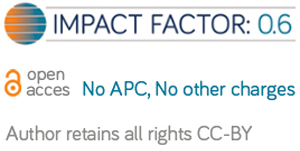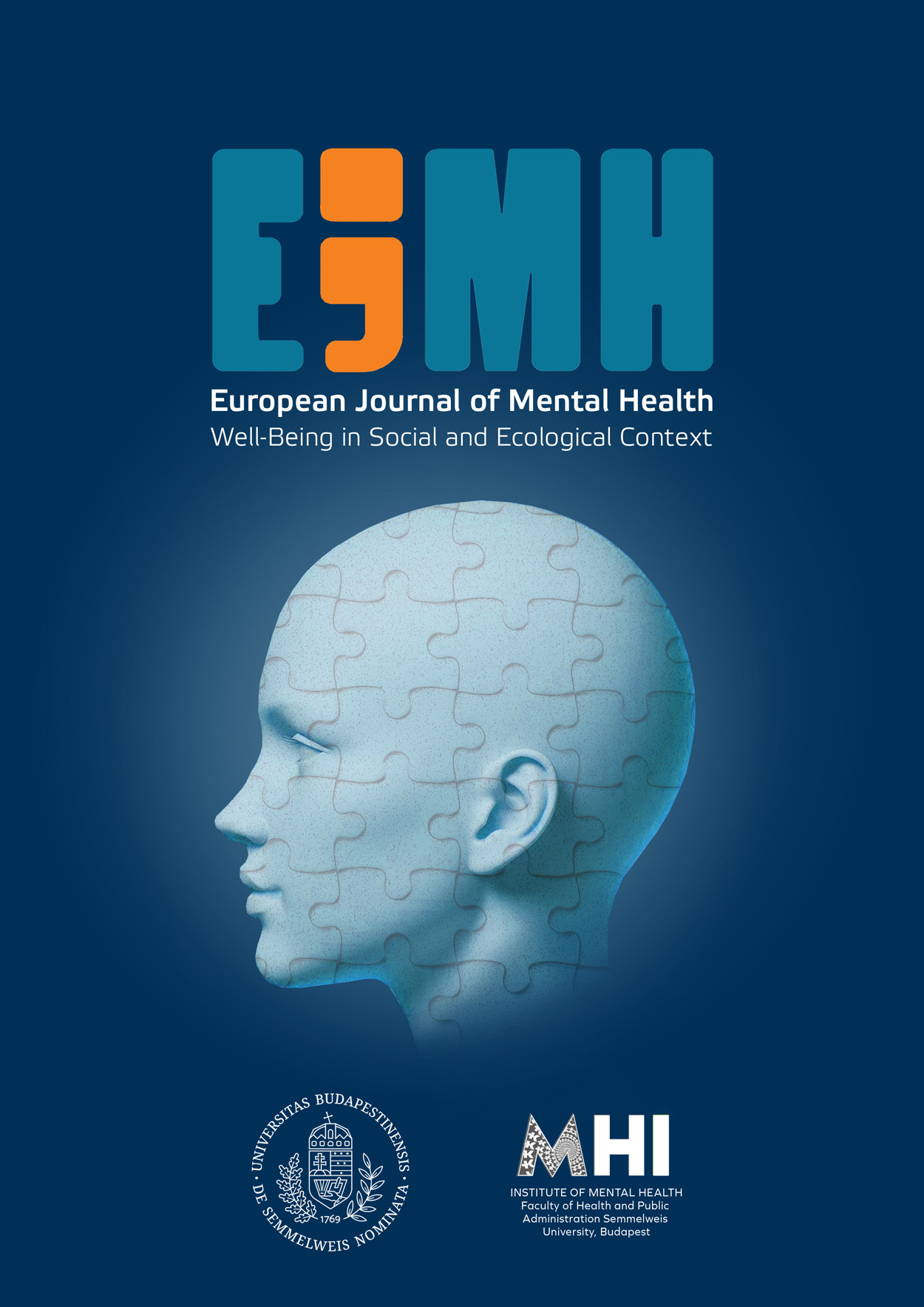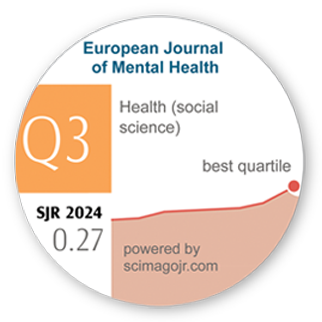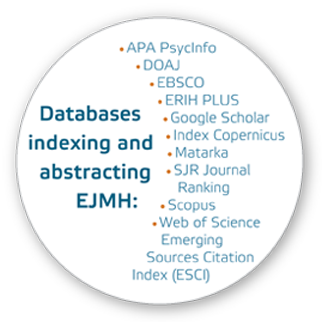Cross-Cultural Differences in Psychological Health, Perceived Stress, and Coping Strategies of University Students During the COVID-19 Pandemic
DOI:
https://doi.org/10.5708/EJMH.17.2022.2.8Keywords:
coping, cross-cultural, COVID-19, psychological health, university studentsAbstract
Introduction: COVID-19 has affected the entire world, including university students. Students are likely to experience COVID-19 related stress that might adversely affect their psychological health and result in various coping strategies.
Aims: This study’s objectives were to examine cross-cultural differences and the relationships between stress, psychological health, and coping among university students during the pandemic. Furthermore, the study explored whether coping strategies mediated the relationship between psychological health and perceived distress for this population.
Methods: University students (n = 703) were recruited via convenience sampling from Indonesia, Malaysia, the Philippines, Thailand, the United States, and the United Kingdom. Participants completed an online quantitative questionnaire consisting of demographics, the Perceived Stress Scale, the General Health Questionnaire, and the Brief-COPE.
Results: Perceived psychological distress was significantly associated with poorer general psychological health and both were associated with dysfunctional coping. For all countries, psychological health mediated the relationship between perceived distress and dysfunctional coping. Students from individualistic cultures reported higher stress and poorer psychological health when compared to those from collectivistic countries. The latter tended to engage in more emotion-focused and problem-focused coping and used more dysfunctional coping strategies than the former.
Conclusions: Future research should explore other mediators and moderators that affect university students’ responses to pandemics and should include longitudinal studies with larger samples. Findings emphasize the need for providing university students with mental health support during and after COVID-19. It is important to develop and research empirically based strategies for reducing their stress and psychological distress through effective and culturally appropriate coping strategies.
References
Abubakar, A., & Fischer, R. (2012). The factor structure of the 12‐item General Health Questionnaire in a literate Kenyan population. Stress and Health, 28(3), 248–254.
https://doi.org/10.1002/smi.1420
Araya, R., Wynn, R., & Lewis, G. (1992). Comparison of two self-administered psychiatric questionnaires (GHQ-12 and SRQ-20) in primary care in Chile. Social Psychiatry and Psychiatric Epidemiology, 27(4), 168–173.
https://doi.org/10.1007/BF00789001
Bjorck, J. P., Cuthbertson, W., Thurman, J. W., & Lee, Y. S. (2001). Ethnicity, coping, and distress among Korean Americans, Filipino Americans, and Caucasian Americans. Journal of Social Psychology, 141(4), 421–442.
https://doi.org/10.1080/00224540109600563
Böke, B. N., Mills, D. J., Mettler, J., & Heath, N. L. (2019). Stress and coping patterns of university students. Journal of College Student Development, 60(1), 85–103.
https://doi.org/10.1353/csd.2019.0005
Calonge, D. S., Aguerrebere, P. M., Hultberg, P., & Connor, M. (2021). Were higher education institutions communication strategies well suited for the COVID-19 pandemic? Journal of Education and Learning, 10(4), 1.
https://doi.org/10.5539/jel.v10n4p1
Carver, C. S. (1997). You want to measure coping but your protocol’s too long: Consider the brief cope. International Journal of Behavioral Medicine, 4(1), 92–100.
https://doi.org/10.1207/s15327558ijbm0401_6
Chun, C., Enomoto, K., & Sue, S. (1996). Health care issues among Asian Americans: Implications of somatization. In P. M. Kato & T. Mann (Eds.), Handbook of diversity issues in health psychology (pp. 347−365). The Plenum Series in Culture and Health. Springer, Boston, MA.
https://doi.org/10.1007/978-0-585-27572-7_18
Cole, P. M., Bruschi, C. J., & Tamang, B.L. (2002). Cultural differences in children’s emotional reactions to difficult situations. Child Development, 73(3), 983–996.
https://doi.org/10.1111/1467-8624.00451
Dias, C., Cruz, J. F., & Fonseca, A. M. (2012). The relationship between multidimensional competitive anxiety, cognitive threat appraisal, and coping strategies: A multi-sport study. International Journal of Sport Exercise Psychology, 10(1), 52–65.
https://doi.org/10.1080/1612197X.2012.645131
Delfino, J. P., Barragán, E., Botella, C., Braun, S., Bridler, R., Camussi, E., Chafrat, V., Lott, P., Mohr, C., Moragrega, I., Papagno, C., Sanchez, S., Seifritz, E., Soler, C., & Stassen, H. H. (2015). Quantifying insufficient coping behavior under chronic stress: A cross-cultural study of 1,303 students from Italy, Spain and Argentina. Psychopathology, 48(4), 230–239.
https://doi.org/10.1159/000381400
Demakis, G. J., & McAdams, D. P. (1994). Personality, social support, and well-being among first year college students. College Student Journal, 28(2), 235–243.
Fasoro, A. A., Oluwadare, T., Ojo, T. F., & Oni, I. O. (2019). Perceived stress and stressors among first-year undergraduate students at a private medical school in Nigeria. Journal of Taibah University Medical Sciences, 14(5), 425–430.
https://doi.org/10.1016/j.jtumed.2019.08.003
Foresman, B. (2020, March 12.). Here are the U.S. universities that have closed due to coronavirus. Edscoop.
https://edscoop.com/universities-closed-due-coronavirus-2020/
Ganesan, Y., Talwar, P., Fauzan, N., & Oon, Y. B. (2018). A study on stress level and coping strategies among undergraduate students. Journal of Cognitive Sciences and Human Development, 3(2), 37–47.
https://doi.org/10.33736/jcshd.787.2018
Gardner, P. J., & Moallef, P. (2015). Psychological impact on SARS survivors: Critical review of the English language literature. Canadian Psychology/Psychologie canadienne, 56(1), 123–135.
https://doi.org/10.1037/a0037973
Ghalechi, E. R., & Movahhed, F. S. (2013). 324 – Teaching coping skills effects on decreasing mental disorders symptoms of students. European Psychiatry, 28(Supplement 1), 1–1.
https://doi.org/10.1016/s0924-9338(13)75730-4
Goldberg, D. P., Gater, R., Sartorius, N., Ustun, T. B., Piccinelli, M., Gureje, O., & Rutter, C. (1997). The validity of two versions of the GHQ in the WHO study of mental illness in general health care. Psychological Medicine, 27(1), 191–197.
https://doi.org/10.1017/s0033291796004242
Hofstede, G. (2001). Culture’s Consequences: Comparing values, behaviors, institutions and organizations across nations (2nd ed.). Sage Publications.
Holahan, C. J., Moos, R. H., Holahan, C. K., Brennan, P. L., & Schutte, K. K. (2005). Stress generation, avoidance coping, and depressive symptoms: A 10-year model. Journal of Consulting and Clinical Psychology, 73(4), 658–666.
https://doi.org/10.1037/0022-006x.73.4.658
Horesh, D., & Brown, A. D. (2020). Traumatic stress in the age of COVID-19: A call to close critical gaps and adapt to new realities. Psychological Trauma: Theory, Research, Practice, and Policy, 12(4), 331–335.
https://doi.org/10.1037/tra0000592
Hwang, W. C., Myers, H. F., Abe-Kim, J., & Ting, J. Y. (2008). A conceptual paradigm for understanding culture's impact on mental health: The cultural influences on mental health (CIMH) model. Clinical Psychology Review, 28(2), 211–227.
https://doi.org/10.1016/j.cpr.2007.05.001
Inauen, J., & Zhou, G. (2020). Health and well‐being in the early stages of the Covid‐19 pandemic: Insights from applied psychology. Applied Psychology: Health and Well-Being, 12(4), 937–945.
https://doi.org/10.1111/aphw.12245
John, A. (2020, March 25). Increased anxiety and depression top college students’ concerns in coronavirus survey. Los Angeles Times. https://www.latimes.com/california/story/2020-03-25/college-students-anxiety-depression-coronavirus-survey
Koh, E. B. Y., Pang, N. T. P., Shoesmith, W. D., James, S., Nor Hadi, N. M., & Loo, J. L. (2020). The behaviour changes in response to COVID-19 pandemic within Malaysia. Malaysian Journal of Medical Sciences, 27(2), 45–50.
https://doi.org/10.21315/mjms2020.27.2.5
Kuo, B. C. H. (2011). Culture’s consequences on coping: Theories, evidences, and dimensionalities. Journal of Cross-Cultural Psychology, 42(6), 1084–1100.
https://doi.org/10.1177/0022022110381126
Lee, E.-H. (2012). Review of the psychometric evidence of the perceived stress scale. Asian Nursing Research, 6(4), 121–127.
https://doi.org/10.1016/j.anr.2012.08.004
Lee, H., & Mason, D. (2014). Cultural and gender differences in coping strategies between Caucasian American and Korean American older people. Journal of Cross-Cultural Gerontology, 29, 429–446.
https://doi.org/10.1007/s10823-014-9241-x
Liu, X. Liu, J. & Zhong, X. (2020). Psychological state of college students during COVID-19 epidemic. [Preprint]. The Lancet Global Health.
http://dx.doi.org/10.2139/ssrn.3552814
Mahmoud, J. S., Staten, R., Hall, L. A., & Lennie, T. A. (2012). The relationship among young adult college students’ depression, anxiety, stress, demographics, life satisfaction, and coping styles. Issues in Mental Health Nursing, 33(3), 149–156.
https://doi.org/10.3109/01612840.2011.632708
Main, A., Zhou, Q., Ma, Y., Luecken, L. J., & Liu, X. (2011). Relations of SARS-related stressors and coping to Chinese college students' psychological adjustment during the 2003 Beijing SARS epidemic. Journal of Counseling Psychology, 58(3), 410–423.
https://doi.org/10.1037/a0023632
McCambridge, J., Witton, J., & Elbourne, D. R. (2014). Systematic review of the Hawthorne effect: new concepts are needed to study research participation effects. Journal of Clinical Epidemiology, 67(3), 267–277.
https://doi.org/10.1016/j.jclinepi.2013.08.015
Meyer, B. (2001). Coping with severe mental illness: Relations of the brief COPE with symptoms, functioning, and well-being. Journal of Psychopathology and Behavioral Assessment, 23, 265–277.
https://doi.org/10.1023/A:1012731520781
Mohr, C., Braun, S., Bridler, R., Chmetz, F., Delfino, J. P., Kluckner, V. J., Lott, P., Schrag, Y., Seifriz, E., & Stassen, H. H. (2014). Insufficient coping behavior under chronic stress and vulnerability to psychiatric disorders. Psychopathology, 47(4), 235–43.
https://doi.org/10.1159/000356398
Mukhsam, M. H., Jeffree, M. S., Pang, N. T. P., Rahim, S. S. S. A., Omar, A., Abdullah, M. S., Lukman, K. A., Giloi, N. B., Salvaraji, L., Abd Karim, M. R., Saupin, S., Yeap, T., Hayati, F., Ibrahim, M., Muhamad, A., & Zainudin, S. (2020). A University-wide preparedness effort in the alert phase of COVID-19 incorporating community mental health and task-shifting strategies: Experience from a Bornean Institute of Higher Learning. The American Journal of Tropical Medicine and Hygiene, 103(3), 1201–1203.
http://dx.doi.org/10.4269/ajtmh.20-0458
Padrón, A., Galán, I., Durbán, M., Gandarillas, A., & Rodríguez-Artalejo, F. (2012). Confirmatory factor analysis of the General Health Questionnaire (GHQ-12) in Spanish adolescents. Quality of Life Research, 21(7), 1291–1298.
https://doi.org/10.1007/s11136-011-0038-x
Pang, N. T. P., Kamu, A., Hambali, N. L. B., Mun, H. C., Kassim, M. A., Mohamed, N. H., Ayu, F., Rahim, S. S. S. A., Omar, A., & Jeffree, M. S. (2020). Malay version of the Fear of COVID-19 Scale: Validity and reliability. International Journal of Mental Health and Addiction, 20(1), 263–272.
https://doi.org/10.1007/s11469-020-00355-4
Pang, N. T. P., Masiran, R., Tan, K.-A., & Kassim, A. (2020). Psychological mindedness as a mediator in the relationship between dysfunctional coping styles and depressive symp toms in caregivers of children with autism spectrum dis order. Perspectives in Psychiatric Care, 56(3), 649–656. https://doi.org/10.1111/ppc.12481
Pang, N. T. P., Shoesmith, W. D., James, S., Nor Hadi, N. M., Yau, E. K. B., & Lin, L. J. (2020). Ultra-brief psychological interventions for COVID-19 pandemic: Introduction of a locally adapted brief intervention for mental health and psychosocial support service. Malaysian Journal of Medical Sciences, 27(2), 51–56.
https://doi.org/10.21315/mjms2020.27.2.6
Parker, R. S., Haytko, D. L., & Hermans, C. M. (2009). Individualism and collectivism: Reconsidering old assumptions. Journal of International Business Research, 8, 127–139.
Patel, V., Araya, R., Chowdhary, N., King, M., Kirkwood, B., Nayak, S., Simon, G., & Weiss, H. A. (2008). Detecting common mental disorders in primary care in India: A comparison of five screening questionnaires. Psychological Medicine, 38(2), 221–228.
https://doi.org/10.1017/s0033291707002334
Patsali, M. E., Mousa, D. V., Papadopoulou, E. V. K., Papadopoulou, K. K. K., Kaparounaki, C. K., Diakogiannis, I., & Fountoulakis, K. N. (2020). University students’ changes in mental health status and determinants of behaviour during the COVID-19 lockdown in Greece. Psychiatry Research, 292, Article 113298.
https://doi.org/10.1016/j.psychres.2020.113298
Penley, J. A., Tomaka, J., & Wiebe, J. S. (2002). The association of coping to physical and psychological health outcomes: A meta-analytic review. Journal of Behavioral Medicine, 25(6), 551–603.
https://doi.org/10.1023/a:1020641400589
Poulus, D., Coulter, T. J., Trotter, M. G., & Polman, R. (2020). Stress and coping in esports and the influence of mental toughness. Frontiers in Psychology, 11, Article 628.
https://doi.org/10.3389/fpsyg.2020.00628
Qiu, J, Shen, B., Zhao M, Wang, Z., Xie, B., & Xu, Y. (2020). Correction: A nationwide survey of psychological distress among Chinese people in the COVID-19 epidemic: Implications and policy recommendations. General Psychiatry, 33, Article e100213.
http://dx.doi.org/10.1136/gpsych-2020-100213corr1
Ribeiro, Í. J. S., Pereira, R., Freire, I. V., de Oliveira, B. G., Casotti, C. A., & Boery, E. N. (2018). Stress and quality of life among university students: A systematic literature review. Health Professions Education, 4(2), 70–77.
https://doi.org/10.1016/j.hpe.2017.03.002
Roberti, J. W., Harrington, L. N., & Storch, E. A. (2006). Further psychometric support for the 10-item version of the Perceived Stress Scale. Journal of College Counselling, 9(2), 135–147.
https://doi.org/10.1002/j.2161-1882.2006.tb00100.x
Robinson, E., Sutin, A. R., Daly, M., & Jones, A. (2022). A systematic review and meta-analysis of longitudinal cohort studies comparing mental health before versus during the COVID-19 pandemic in 2020. Journal of Affective Disorders, 296, 567–576.
https://doi.org/10.1016/j.jad.2021.09.098
Rubin, G. J., & Wessely, S. (2020). The psychological effects of quarantining a city. BMJ.
https://doi.org/10.1136/bmj.m313
Sahu, P. (2020). Closure of universities due to coronavirus disease 2019 (COVID-19): Impact on education and mental health of students and academic staff. Cureus, 12(4), Article e7541.
https://doi.org/10.7759/cureus.7541
Salvaraji, L., Rahim, S. S. S. A., Jeffree, M. S., Omar, A., Pang, N. T. P., Ahmedy, F., Hayati, F., Yeap, T., Giloi, N., Saupin, S., Muhamad, A., & Zainudin, S. (2020). The importance of high index of suspicion and immediate containment of suspected COVID-19 cases in institute of higher education Sabah, Malaysia, Borneo. Malaysian Journal of Public Health Medicine, 20(2), 74–83.
http://dx.doi.org/10.37268/mjphm/vol.20/no.2/art.573
Sandhu, S. S., Ismail, N. H., & Rampal, K. G. (2015). The Malay version of the perceived stress scale (PSS)-10 is a reliable and valid measure for stress among nurses in Malaysia. The Malaysian Journal of Medical Sciences, 22(6), 26–31.
Sher, L. (2020). Are COVID-19 survivors at increased risk for suicide? Acta Neuropsychiatrica, 32(5), Article 270.
https://doi.org/10.1017/neu.2020.21
Shulruf, B., Hattie, J., & Dixon, R. (2007). Development of a new measurement tool for individualism and collectivism. Journal of Psychoeducational Assessment, 25(4), 385–401.
https://doi.org/10.1177/0734282906298992
Tada, A. (2017). The Associations among Psychological Distress, Coping Style, and Health Habits in Japanese Nursing Students: A Cross-Sectional Study. International Journal of Environmental Research and Public Health, 14(11), Article 1434.
https://doi.org/10.3390/ijerph14111434.
The American College Health Association. (2007). American College Health Association National College Health Assessment Spring 2006 Reference Group Data Report (Abridged). Journal of American College Health, 55(4), 195–206.
https://doi.org/10.3200/jach.55.4.195-206
Triandis, H. C. (1995). Individualism and Collectivism. Routledge.
https://doi.org/10.4324/9780429499845
Usher, K., Durkin, J., & Bhullar, N. (2020). The COVID‐19 pandemic and mental health impacts. International Journal of Mental Health Nursing, 29(3), 315–318.
https://doi.org/10.1111/inm.12726
Wang, C., Pan, R., Wan, X., Tan, Y., Xu, L., McIntyre, R. S., Choo, F. N., Tran, B., Ho, R., Sharma, V. K., & Ho, C. (2020). A longitudinal study on the mental health of general population during the COVID-19 epidemic in China. Brain, Behavior, and Immunity, 87, 40–48.
https://doi.org/10.1016/j.bbi.2020.04.028
Zhao, S., & Zhang, J. (2018). The association between depression, suicidal ideation and psychological strains in college students: A cross-national study. Culture, Medicine and Psychiatry, 42(4), 914–928.
https://doi.org/10.1007/s11013-018-9591-x
Zhou, Y. (2020, March 26). How international students are supposed to deal with coronavirus, according to their US universities. Quartz. https://qz.com/1822530/us-universities-coronavirus-plans-for-international-students/






